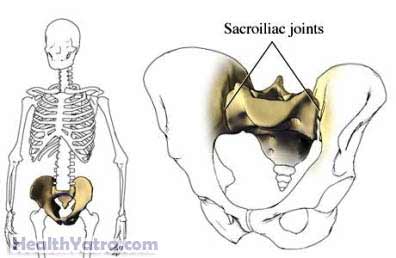Definition
The sacroiliac joint is in the low back where the spine meets the pelvis. Sacroiliac joint pain is discomfort in this area. This pain is a symptom that may come from a number of conditions or diseases.

Causes
Doctors may be unsure if the pain starts in the joint or in its surrounding ligaments. Ligaments are bands of tissue that connect one bone to another. It is also difficult to tell if the pain is coming from the sacroiliac joint or the small joints in the lower spine. These smaller joints are called facet joints.
The sacroiliac joint has many nerve endings. The nerves send pain signals to the brain. Pain in this region may be caused by many factors:
- Twisting, bending, or moving in a way that triggers sacroiliac joint pain
- Infection of the joint
- Osteoarthritis of the joint (more common in older adults)
- Trauma, such as auto accidents
- Stress fractures in athletes
- Inflammation of the joint, such as with ankylosing spondylitis
Risk Factors
Factors that increase your chance for sacroiliac joint pain include:
- Poor posture
- Weak muscles
- Bending or twisting the back
- Improper lifting
- Ankylosing spondylitis
- Psoriatic arthritis
Symptoms
Symptoms include:
- Mild-to-severe low back pain
- Pain in the buttocks
- Pain that seems deep in the pelvis
- Pain in the hip or groin or back of the thigh
- Pain that radiates down the leg on the affected side
- Stiffness of the lower spine
- Certain activities may increase the pain, including:
- Walking
- Twisting
- Bending
- Stooping
- Rolling over in bed
- Getting up from a chair
- Climbing the stairs
- Coughing
- Sneezing
Diagnosis
The doctor will ask about your symptoms and medical history, and perform a physical exam. Finding the source of sacroiliac joint pain is often difficult. Tests depend on your medical history and the suspected cause.
Tests may include:
- X-rays of the pelvis and lower back
- Bone scan—an injection of radioactive material into the body, followed by scanning with a machine that will find areas with higher concentrations of the injected material (these are areas of abnormal bone activity)
- CT scan—a type of x-ray that uses a computer to make pictures of the inside of the pelvis and sacroiliac joint
- MRI scan—a test that uses a strong magnetic field and radio waves to make pictures of the sacroiliac joints and the ligaments
- Biopsy or aspiration—removal of a sample of tissue from the joint for testing
- Joint injections or nerve blocks—injection of a drug that blocks nerve signals into the joint to determine if the pain starts in the joint
Treatment
Treatment depends on the cause of the pain. Any underlying condition would receive treatment specific for that disease. For stress fractures, doctors recommend limited weight-bearing. Regardless of the cause, short-term rest is often advised.
Other treatment may include:
Medication
Your doctor may recommend or prescribe any of the following:
- Nonsteroidal anti-inflammatory drugs (NSAIDs), such as:
- Aspirin
- Ibuprofen (Motrin, Advil)
- Pain medication—acetaminophen (Tylenol)
- Steroid injections into the sacroiliac joint
- Antibiotics for infected joints
- Radiowave treatment of nerves around the joint—for severe pain that does not respond to other treatments
Physical Therapy
Physical therapy may include:
- Exercises to stretch the muscles of the lower back
- Exercises to strengthen the muscles which support the area
- Exercises to affect the motion of the sacroiliac joint
- Applying ice to the painful area
- Applying deep heat to the sore area
Back Care
Prevent stress to the painful area with the following:
- Proper bending
- Proper lifting
- No twisting of the body
Prevention
Practicing good back care may help you avoid sacroiliac joint pain. This includes:
- Exercise regularly to keep muscles strong.
- Maintain good posture.
- Use proper techniques for bending or lifting.
